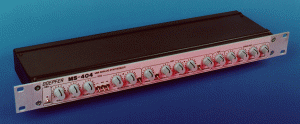The Doepfer MS404 was designed as a TB emulator with a lot of added features in a period full of cheap and expensive tb clones.
The 404 in fact is not a clone but has a clear personality and can be considered more a single VCO monosynth.
First I want to describe the structure of the synth: a single VCO , with saw/pulse/PWM or noise with a 24dB ladder filter, a VCA with accent and a adsr Envelope generator and two indipendent LFO that can go up to audio frequency!
The VCO seems to be the A110 “standard vco” available as a module for the A100 modular system, but opening the case , I read on the board “HI END VCO”,and that sounds strange because I did not see any CEM3340 as on the A111 “hi end VCO”.
The VCO section has 5 knobs and 3 swithches.
Knobs are: GLIDE, TUNE (fine tune) , LEVEL (LFO1 amount) FREQ (LFO1 rate).
the switches select:
- saw/pulse/none
- vco/noise/none
- pwm/fm/none
- rate (hi-mid-low)
The VCF section has 5 knobs :
- Frequency
- Envelope
- Modulation level(LFO2)
- Modulation Frequency (LFO2)
- Emphasis (Resonance)
and 2 switches : one for the filter tracking and omne for the LFO2 range (hi-mid-low).
The VCF is the same as the A120 MOOG ladder filter eurorack module for the A100.
The VCA has a knob control for the accent amount and the envelope is the classic adsr.
speaking about the sound the 404 has a distinct doepfer carachter, it sounds exactly as the A100 modular system, no audible differences.
The synth behaves as a tb clone if the added features are not used, and with the emphasis quite low.
When you rise the emphasis it takes squelching in a more hard way and at self oscillation it can produce a sine wave , musically playable switching the filter tracking ON.
the PWM sounds awesome, I like it very much, because it does not intend to clone but has a “new minimal sound” very interesting for those involved in minimal techno like Ritchie Hawtin…
It does not sound nor similar to a Roland SH-101, this is more acid and hard, the SH is fuller on low frequencies and smoother.
The interesting feature that makes the doepfer ms 404 a distinct machine is the use of fast lfo to modulate VCO and VCF.
The LFOs are derived from the A145 (doepfer A100 system) and have a range switch that allows very low oscillation to fast audio range FM.
That’s interesting because the filter is a 24dB Moog Ladder type, a filter that has a fast reaction to modulations and can create incredibles sounds if modulated in self oscillation or nearby…
Using the other LFO on the VCO can create some interesting noise or FM sounds useful for percussions, drones etc.
One thing to say…
The waveform orf the LFOs are fixed, triangle or square and you can choose the one you want to use only using a jumper on the board, there are no external switches.
The impression I had playng the MS 404 is really good.
This is a interesting bassline synth , not so good at emulating the classic TB sound, but this is a good point!
Other than that can be used as a classic monosynth with a great modulation capability, and many sounds with a small amount of functions and knobs.
There is also an audio in (with gain) to process external audio signals and a cv-gate interface (in/out) so the 404 can be played trhu cv by an analog system/sequencer or can be used to control other cv-gate synth.
I prefer the 404 to a Basstation , for example , it sounds more interesting and “analog” and is not the “wannabe everything” emulator.





